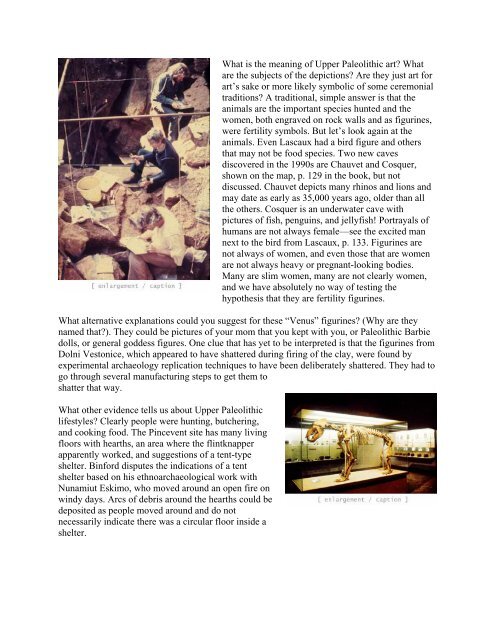INTRODUCTION TO ARCHAEOLOGY Nancy White - Touro Institute
INTRODUCTION TO ARCHAEOLOGY Nancy White - Touro Institute
INTRODUCTION TO ARCHAEOLOGY Nancy White - Touro Institute
You also want an ePaper? Increase the reach of your titles
YUMPU automatically turns print PDFs into web optimized ePapers that Google loves.
What is the meaning of Upper Paleolithic art? What<br />
are the subjects of the depictions? Are they just art for<br />
art’s sake or more likely symbolic of some ceremonial<br />
traditions? A traditional, simple answer is that the<br />
animals are the important species hunted and the<br />
women, both engraved on rock walls and as figurines,<br />
were fertility symbols. But let’s look again at the<br />
animals. Even Lascaux had a bird figure and others<br />
that may not be food species. Two new caves<br />
discovered in the 1990s are Chauvet and Cosquer,<br />
shown on the map, p. 129 in the book, but not<br />
discussed. Chauvet depicts many rhinos and lions and<br />
may date as early as 35,000 years ago, older than all<br />
the others. Cosquer is an underwater cave with<br />
pictures of fish, penguins, and jellyfish! Portrayals of<br />
humans are not always female—see the excited man<br />
next to the bird from Lascaux, p. 133. Figurines are<br />
not always of women, and even those that are women<br />
are not always heavy or pregnant-looking bodies.<br />
Many are slim women, many are not clearly women,<br />
and we have absolutely no way of testing the<br />
hypothesis that they are fertility figurines.<br />
What alternative explanations could you suggest for these “Venus” figurines? (Why are they<br />
named that?). They could be pictures of your mom that you kept with you, or Paleolithic Barbie<br />
dolls, or general goddess figures. One clue that has yet to be interpreted is that the figurines from<br />
Dolni Vestonice, which appeared to have shattered during firing of the clay, were found by<br />
experimental archaeology replication techniques to have been deliberately shattered. They had to<br />
go through several manufacturing steps to get them to<br />
shatter that way.<br />
What other evidence tells us about Upper Paleolithic<br />
lifestyles? Clearly people were hunting, butchering,<br />
and cooking food. The Pincevent site has many living<br />
floors with hearths, an area where the flintknapper<br />
apparently worked, and suggestions of a tent-type<br />
shelter. Binford disputes the indications of a tent<br />
shelter based on his ethnoarchaeological work with<br />
Nunamiut Eskimo, who moved around an open fire on<br />
windy days. Arcs of debris around the hearths could be<br />
deposited as people moved around and do not<br />
necessarily indicate there was a circular floor inside a<br />
shelter.
















